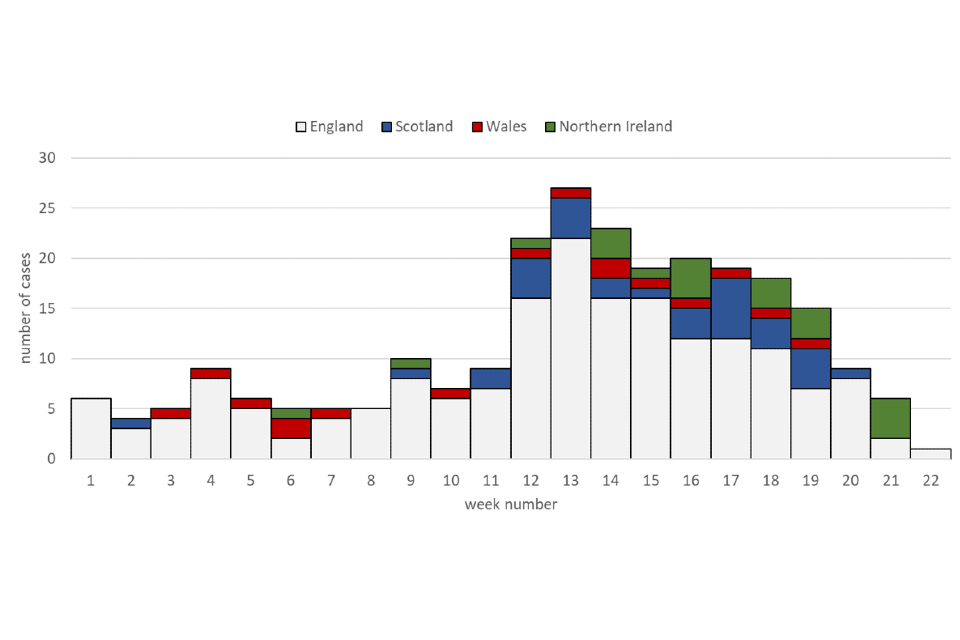Investigation into acute hepatitis of unknown aetiology in children in England: case update
Updated 23 May 2023
Applies to England
This is an epidemiological briefing produced to share data useful to other public health investigators. Full technical briefings will continue to be produced when appropriate.
For the purposes of this summary, cases refer to confirmed (10 years old and under) and possible (11 to 15 year old) cases – see case definition in Technical Briefing 3. The public health agencies of the 4 nations continue to work with the NHS to classify reported case-patients who have incomplete laboratory information (referred to as ‘pending’).
Cases in the UK
As of 13 June 2022, there are 260 cases (251 confirmed and 9 possible) cases of acute non-A-E hepatitis with serum transaminases greater than 500 IU/l identified in children aged under 16 years old in the UK, since 1 January 2022. Of these, 187 cases (180 confirmed and 7 possible) are resident in England, 32 (all confirmed) in Scotland, 17 (all confirmed) in Wales and 24 (22 confirmed and 2 possible) in Northern Ireland (Figure 1). This is the result of an active case-finding investigation starting in April which identified retrospective as well as prospective cases.
Between 21 January and 13 June 2022, 12 children in the UK meeting the case definition have required liver transplantation; no cases resident in the UK have died.
While new cases continue to be identified across the UK, there is an overall decline in the number of new cases reported per week, even allowing for reporting lags. Cases pending classification are usually those in which laboratory testing to rule out known causes of hepatitis has not been completed.

Figure 1. Cases by week of presentation, 1 January to 13 June 2022
Supplementary data is not available for this figure.
Date not available for 6 cases in England, 3 cases in Northern Ireland and 1 case in Wales. Week is based on hospitalisation date where available, then date of arrival at emergency care department where available, then date of presentation to healthcare.
Associated pathogens
Adenovirus remains the most frequently detected potential pathogen in cases. Amongst 260 UK cases, 241 have been tested for adenovirus, of which 156 (64.7%) had adenovirus detected. SARS-CoV-2 has been detected around the time of admission in 34 of 196 UK cases with available results (17.3%), although in English cases only the proportion positive was lower (9.7%).
Cases in England
As of 13 June 2022, there were 187 (180 confirmed and 7 possible) cases in England. There are no known epidemiologically linked cases in England. Twenty-two potential cases in England are awaiting classification pending further data. Cases are predominantly aged between 3 and 5 years old (99; 52.9%), median age 3 (interquartile range: 2 to 5 years) and 49% are female. The majority are of white ethnicity (142 out of 187; 88.2%) where information was available. Nine cases who were resident in England required a liver transplant.
Laboratory data on pathogens reported by the NHS and public health laboratories through SGSS are routinely monitored for changes in trends and statistical exceedances. There has been a marked exceedance of adenovirus since the end of 2021, apparently driven by adenovirus in faecal samples and in the 1 to 4 year old age group, although the number of laboratory diagnoses is now decreasing.
